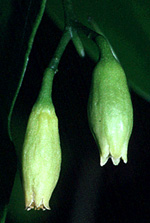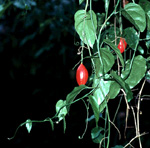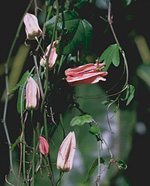 |
This is a large, tropical family, particularly rich in South America. In Australia, most species are found in rainforests and monsoonal forests across the tropical north, from the Kimberley region to warm parts of the east coast, although one native species and several introduced ones extend south into eastern Victoria and Tasmania.
Characteristic features of the family Passifloraceae in Australia include: - climbers with prominent, coiled tendrils arising from the axils of the alternate, entire or palmately lobed leaves
- flowers solitary in the leaf axils, white, red, pink, purplish or blue, with 5 free sepals and petals, the sepals often similar to the petals
- corolla usually bearing a corona - a ring of finger-like processes around the centre of the flower
- stamens 5, joined into a tube sheathing a stalk (gynophore) on which sits the ovary crowned by a 3-branched style
- fruit a berry filled with pulpy flesh and hard seeds
Description
Evergreen or semi-deciduous, woody or perennial herbaceous vines, climbing by axillary tendrils. Perennating by tubers or taproots. Extra-floral nectaries absent or on the foliage. Stem internodes solid, spongy or pithy or hollow, terete or distinctly angular. Internal secretions not obvious. Plants glabrous, or with simple, glandular or non-glandular, unicellular or uniseriate hairs. Leaves alternate and spiral, cauline if herbs, petiolate. Stipules absent, or present and distinct and free from the petiole, or ochreate, green and leafy or gland-like, falling off early or persistent. Lamina simple, symmetric, palmatifid or palmatisect, lanceolate, ovate or orbicular; base cuneate, rounded or cordate; margins entire, crenate or serrate, ±flat; venation pinnate, or palmate, with the midrib conspicuous, and the tertiary venation reticulate or not; surfaces punctate or not punctate; herbaceous, leathery, membranous or papery; distinctive odour absent or foetid. Domatia absent or consisting of pockets or hair tufts in the vein angles. All the flowers bisexual. Inflorescences axillary, consisting of cymes or solitary flowers. Bracts and bracteoles present. Pollination by insects. Flowers odourless, sessile or stalked. Floral disc ?present or absent; nectaries absent or present on the disc. Free hypanthium present. Perianth regular, of 2 dissimilar whorls or whorls ±similar, imbricate in bud. Calyx segments free or fused, with (4–) 5 (–6) (or apparently 0) sepals or lobes, herbaceous or papery; base without appendages or carinate. Corolla segments free or fused, with (4–) 5 (–6) petals or lobes, alternating with the sepals or calyx lobes; corolla urn-shaped or tubular, rarely wheel-shaped, white, cream, yellow, orange, red, pink, magenta, purple or green, without contrasting markings, membranous or papery; claws absent; lobes ±entire. Fertile stamens 5 or 10, opposite to the sepals or calyx lobes, free of the corolla, free of or at least partly fused with the ovary or style, fused by their filaments into an open or closed tube and stipitate, all ±equal. Staminodes present or absent. Anthers dorsifixed, versatile, opening inwards by longitudinal slits, 2-celled. Ovary superior and stalked. Carpels 3, fused; ovary with 1 locule. Style terminal, branching from the base. Ovules numerous, stalked; placentation parietal. Fruit a dry dehiscent loculicidal capsule, or a fleshy indehiscent berry; the perianth on the maturing fruit deciduous or dry and persistent. Disseminule micro-surface ±muricate or reticulate, grey or black, conspicuously patterned, glossy or dull. Seeds numerous per fruit. Aril present, elastic. Cotyledons 2. Embryo straight.
(Note: this description has been generated from the coded data compiled for the key. Any errors in the key data will be reflected in the descriptions.)
A treatment of the family Passifloraceae has been published in:
Flora of Australia 8: 147-158.
Australian genera of Passifloraceae (as recognised for the Flora of Australia)
† = some species native, others introduced
Adenia
†Passiflora

|
  |

Adenia heterophylla (flowers)
Photo: G.Sankowski © Zodiac Publications

Adenia heterophylla (fruits)
Photo: G.Sankowski © Zodiac Publications

Passiflora aurantia (flowers)
Photo: D.Greig © ANBG

Passiflora cinnabarina (flower)
Photo: M.Fagg © ANBG

|
 |
|